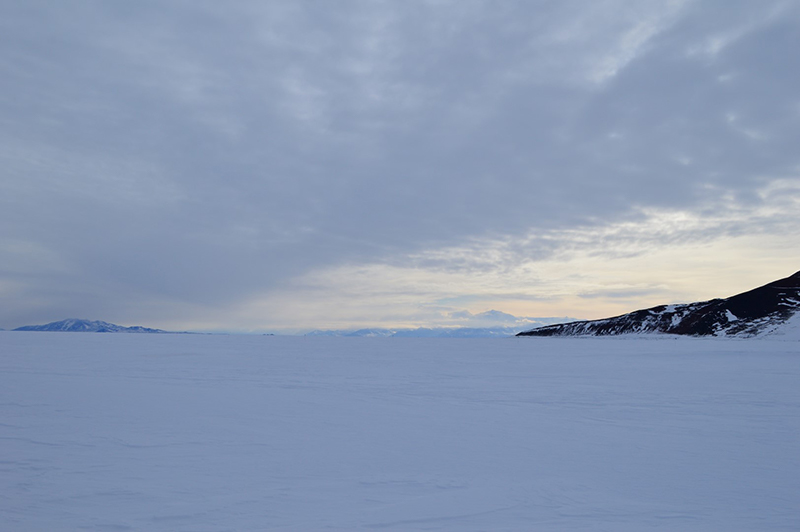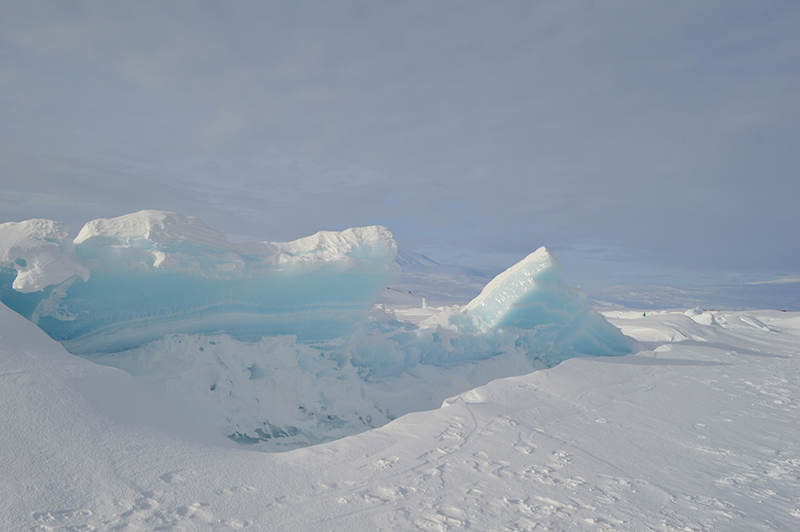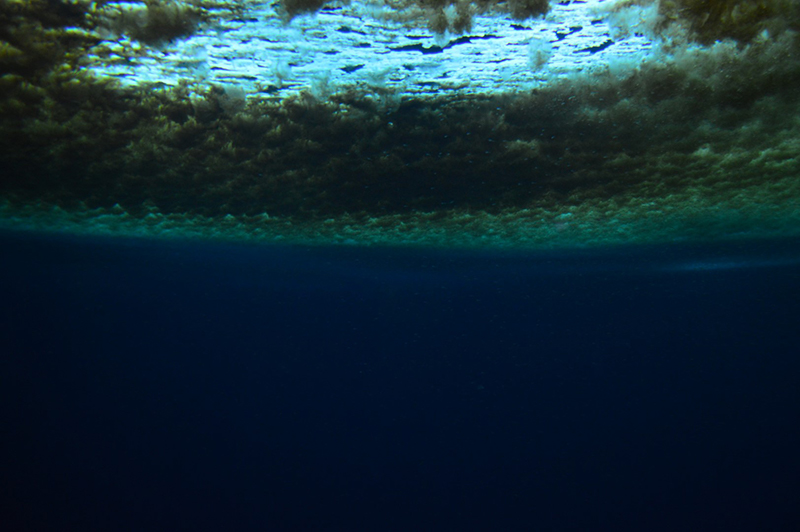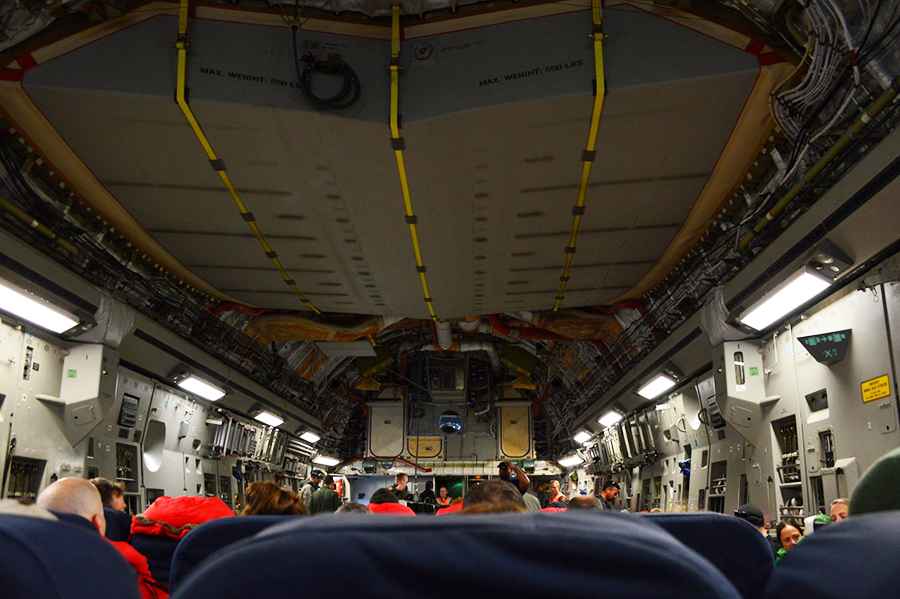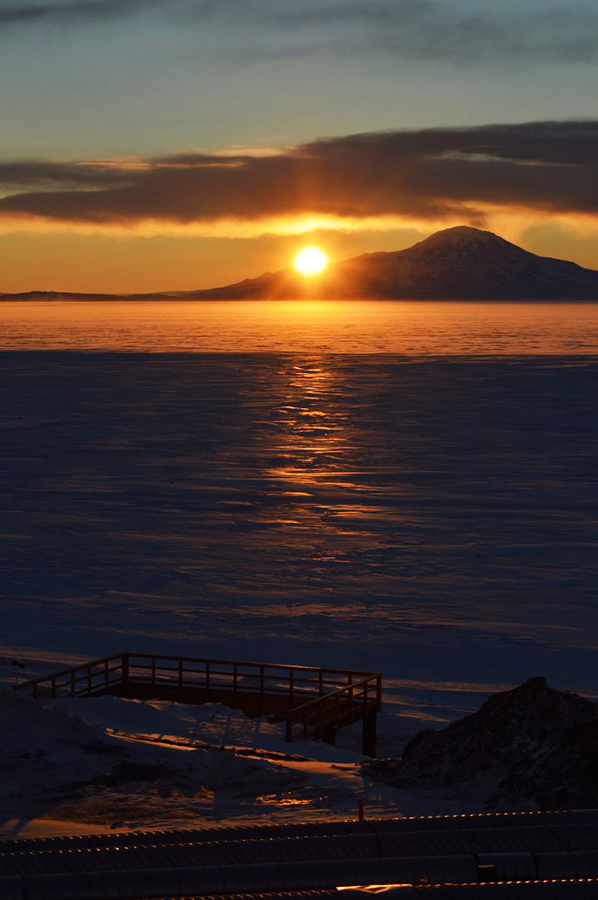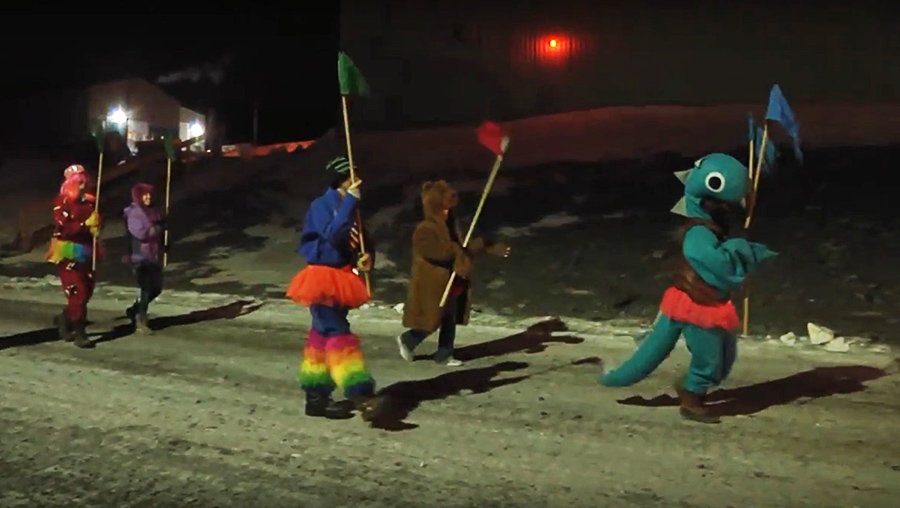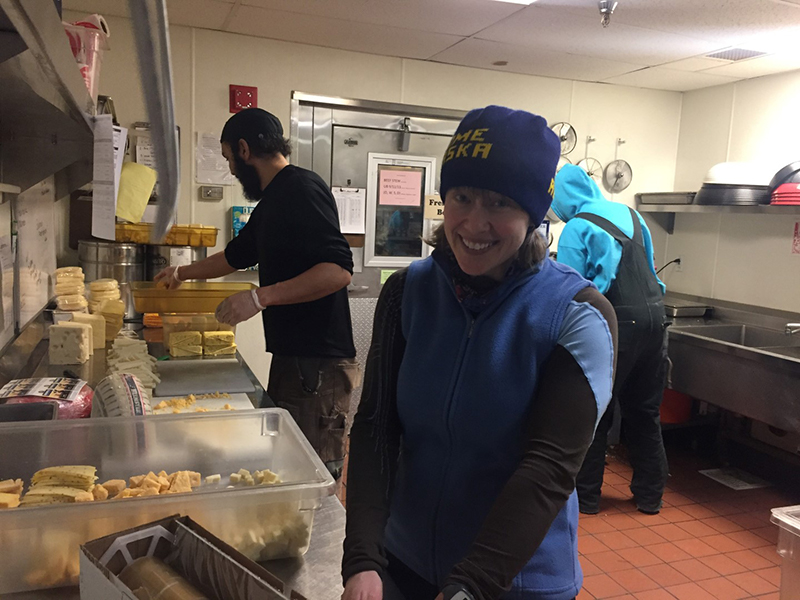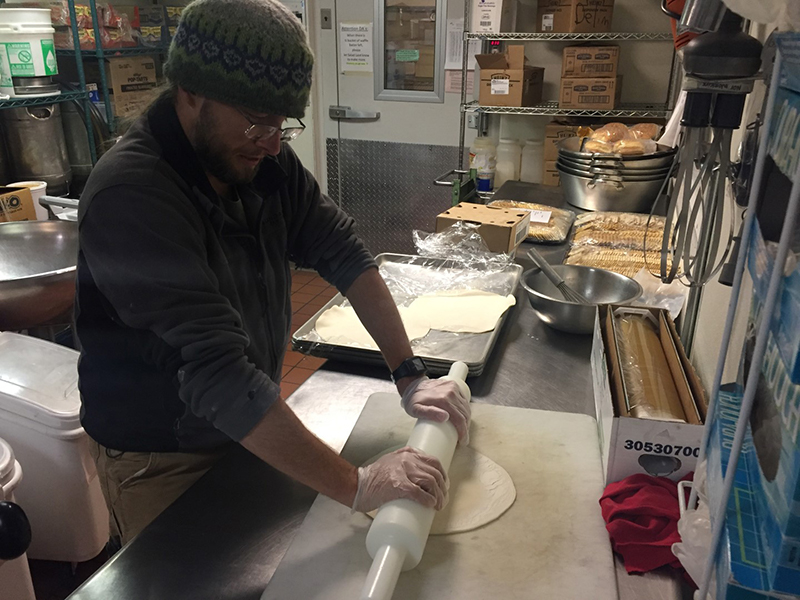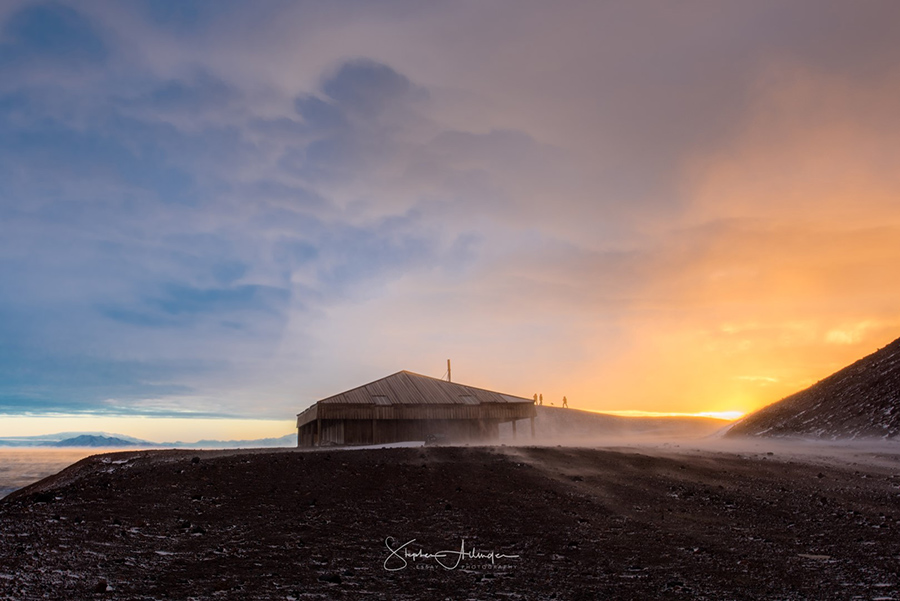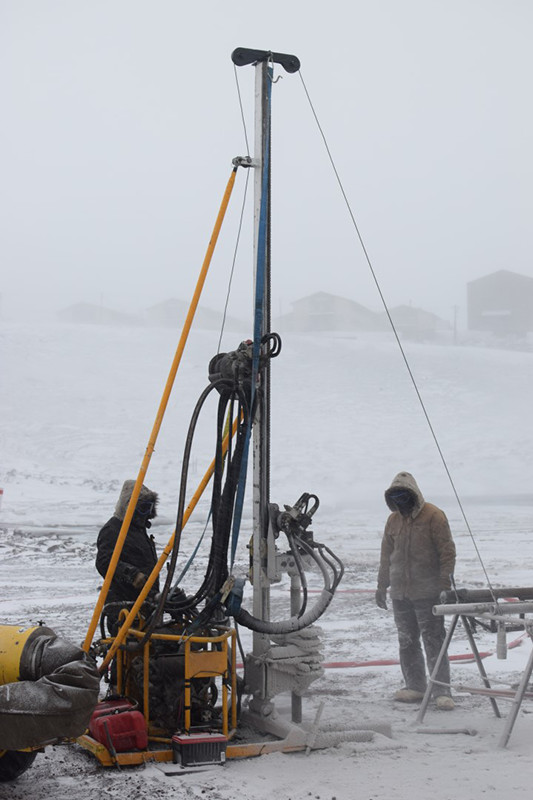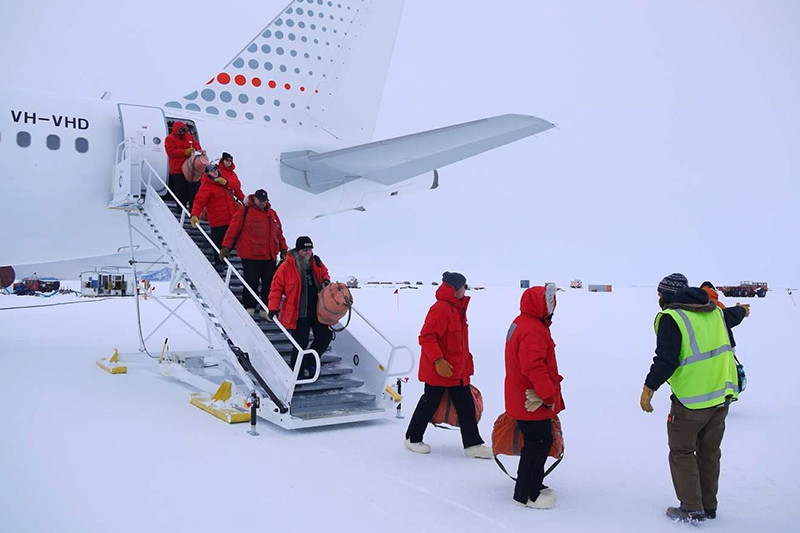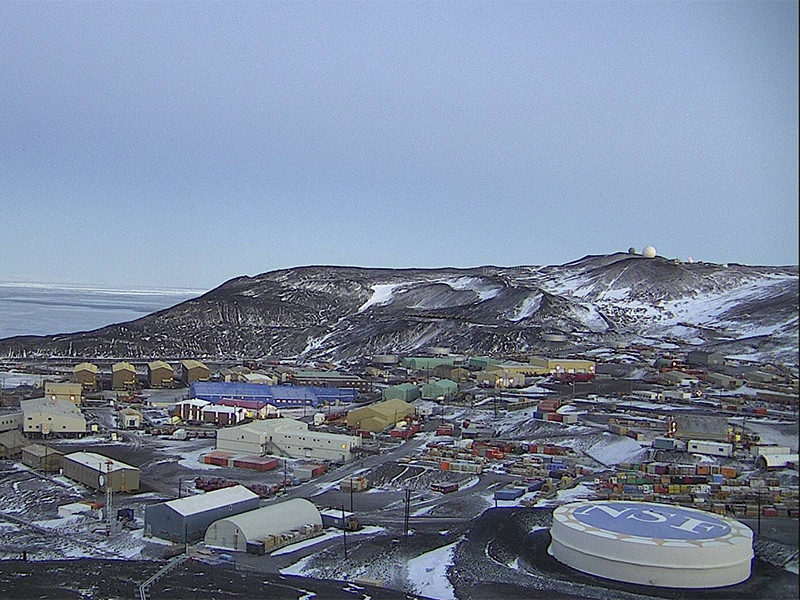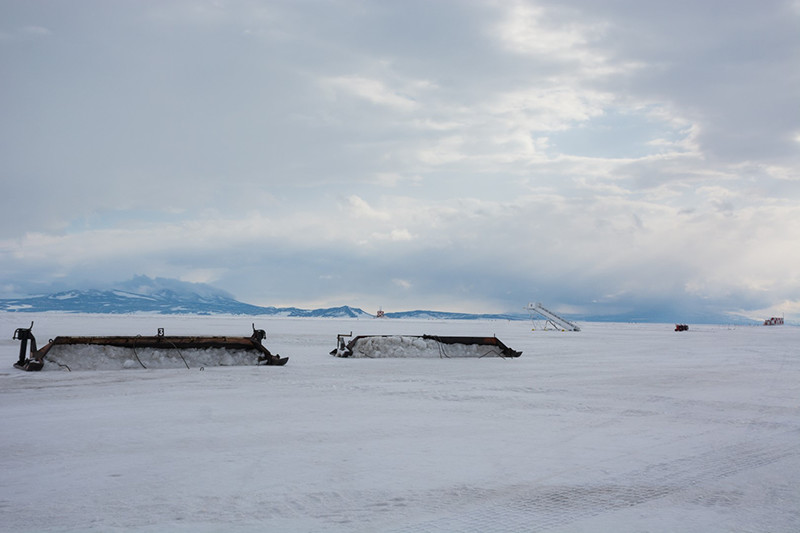|
McMurdo Station Archives - 2017 Summer in Full SwingDecember 11, 2017

Photo Credit: Nicolette Ratz
Seals lay across the sea ice along the pressure ridges adjacent to New Zealand’s Scott Base.
This month it would seem the McMurdo community has settled into the comforts of a steady routine; even those who recently arrived here feel a sense of home. The adjustments to the dry air and cold weather don’t feel like major hurdles any more, countless opportunities for people to enjoy hobbies in their off hours are available and the hiking trails are seeing more feet. The community is usually in a constant state of change – with scientists, artists and support staff continually coming and going – but for now McMurdo looks content. It would be no surprise if the current calm is in part due to the recent weather. The beginning of November brought numerous snow storms causing delays in flights and as a result also, a number of snow angels throughout the area. With a turn in weather towards less wind and warmer days, things are moving smoothly to their rightful places. Most field camps are set up, allowing scientists to begin – or continue – their research. Along with the continuation of science, McMurdo residents were able to see local wildlife. One early sighting was quickly relayed around town and before long most were able to view a mother Weddell seal and her pup near Hut Point. When I went to greet her, she waved. Even though it was likely an effort to cool off, it’s nice to pretend she wanted to say, “Hi.” If that wasn’t cute enough a lucky few caught sight of three Adelie penguins in transit across the sea ice. The group was spotted just outside the Ob Tube, a contraption built to allow folks to look and listen to the diverse marine life below the sea ice. This month’s Ob Tube participants caught sights of Weddell seals, fish, jellyfish, tardigrades and the occasional scuba diver. For those that weren’t able to view a seal in its preferred medium, most were able to hear the eerie calls they emit; Weddell seals produce the largest range of vocalizations of any other seal. For hikers, many trails are open and volunteer-led hikes along the pressure ridges near Scott Base, the New Zealand station down the road from McMurdo, are available. The guided hike offers expansive views of the sea ice and mountains, bright blue ice, and for some, a glimpse of some local Weddell seals. Inside McMurdo Station’s main building, the entire town celebrated Thanksgiving “family style.” The festivity was a surprising, yet not so surprising, big deal. Spending the holidays away from family-cherished recipes and the people you’ve known for decades can be difficult for many. The kitchen and stewards worked hard to make it a special holiday for everyone. A spread of Thanksgiving classics, carving stations, multiple pies and a few unique dishes made their way out to feed a hungry crowd; the race-runners from the annual 5K, the “Turkey Trot,” were especially hungry. Everyone comingled with their family of friends and coworkers and enjoyed a much needed extra day off. Flying South for the Austral SummerDecember 7, 2017
More than a hundred people packed into a C-17 cargo plane headed to Antarctica and no one’s daydream is the same. For first timers, like myself, our thoughts are full of wonder; expectations present, but limited. “What does continuous sunlight feel like?” “Who will I meet?” “Will I see penguins?” are just a few of the exciting uncertainties that arise. Those returning, no doubt, have found the answers to these questions in previous seasons and envision the hugs of friends, the warm familiarity of McMurdo Station and are excited to hit the ground running. It’s a fully functioning – albeit atypical – small town. This is just the first of several flights carrying the majority of the McMurdo summer population, which sees an increase from 150 to about 900 inhabitants within a couple weeks. The cafeteria and dorms fill up as everyone gets settled into their new temporary homes. While new arrivals unpack, those who have spent winter on the station are packed and await their turn to enter the C-17 aircraft to depart. The winter season brought them high clarity southern lights, aurora australis, and coveted views of the galaxy. It is a buzzing time for conversation. The winter and summer crowd mingle and talk of vacations had and vacations to be had. Returnees offer a plethora of advice to bright eyed, sometimes lost, newbies. Everyone heads to work; morning, day and night. It would seem New York City isn’t the only city that never sleeps. One of the more exciting aspects of this transition comes out of the kitchen. With an increase in flights, fresh fruits and vegetables – or “freshies” – are brought in. For the winter citizenry this moment is like Christmas morning. For those of us just arriving, it can hard to imagine what five months without fresh food feels like, with so much available now canned or frozen. But trying to picture the absence of a crisp apple or the inability to make a green salad for months makes one realize it’s a privilege unnoticed until it’s gone. As more people inhabit this ice town, events begin to pop up. There is no shortage of activities to occupy free time, helping to alleviate the disadvantages of isolation. A few include: yoga, sports, billiards, trivia and guided tours of historic huts. While these allow us to feel the comforts of home there is one event that is entirely Antarctic: the McMurdo Halloween Party. The largest party on the continent celebrated the Celtic holiday with a well decorated gym, music, dancing and a costume contest. Aside from more people, October heralded the start of the spring season. While our friends and family back home get ready for winter, summer is on its way. It may lack the green foliage and melting snow, but the local animals – namely seals – have started giving birth and the sun is out in full swing. Not too long ago the sun set for last time, not to dip below the horizon again for several months. And as the days warm everyone at McMurdo will be able to enjoy the beautiful scenery Antarctica has to offer. For my first few weeks “on ice” I’ve found I’m really not that far from home. A Frigid Fourth of JulyAugust 14, 2017
Back home in the United States, July is a time for burgers and hot dogs on the grill, fireworks and days spent poolside. In some ways, our off hours at McMurdo in July are strangely similar. During their lunch hour, McMurdo residents rang in the fourth of July loud and proud with the world’s southernmost Independence Day parade. Led by McMurdo’s military veterans, the parade included a display of vehicles from around the station including (of course) a firetruck, a marching band, “Sir Liberty,” a color-guard, a few dancers and a faux “street sweep” cleaning up behind us. The following Saturday we continued the celebrations. The Science Support Center—or the “eyebrow building” as locals call it thanks to a peculiar arch over the doorway—hosted a festival. There were carnival games including a laser maze, dart-balloon-pop game, ball toss, face painting and more. Guests had the chance to guess how many pieces of candy were in jars in order to win a “sweet” prize, glance through baby pictures and match them with the correct wintering resident, or compete against their friends in a game of corn-hole. The festivities were also the setting of McMurdo’s annual chili cook off! This year’s winners were McMurdo’s weather team, Paul Guilli and Nick Beckius, with their dish titled, “The Chili is Weather.” Other dishes available that evening included some burgers straight off an actual grill, a full barbeque-style spread from the galley and even a cotton-candy machine! Following the Independence Day celebrations, life at McMurdo slowed down. After a month of decent, relatively warm weather, winter at McMurdo finally set in. I’m sure our chili masters could provide more details, but it felt like not a day went by where “Condition 2” didn’t flash in the halls. Many days the areas outside of town and our neighbors at New Zealand’s Scott Base were at Condition 1. Thus, hiking and other outdoor recreation activities gave way to largely indoor ones, but we made do. During our off time in July we kept busy doing with trivia nights, sing-alongs around a “campfire” (really a bucket with Christmas lights in it), the Highlander games hosted by the Fuels Department, rocking out at not one but two Headbanger’s balls and standing in groups outside admiring the beautiful orange skies and the mountains surrounding town that are becoming visible again. The weather did let up enough to afford us a few chances to visit Scott Base and enjoy some lovely dinners cooked by our New Zealand friends, as well as a “throwback” black-light party one night. Lest the reader think July was nothing but recreation, be assured that work maintaining the station continued as normal. In addition, being good stewards of the station is important so volunteers took the time to deep clean all of the recreation facilities and gyms before the busy summer. Other work around the station continues as we begin to de-winterize some of the buildings as part of the preparations for the incoming flood of folks to begin in less than a month. Teamwork at MidwinterJuly 17, 2017

Photo Credit: Kaleigh Hinkley
Postal supervisor James Roth pitches in and helps to clean the kitchen following the glycol spill.
June at McMurdo Station was marked by communal effort. The June 1st flight brought in new faces, long-awaited mail and coveted fresh vegetables. Volunteers in the galley helped to unload and sort the new cargo, meaning that very same night residents saw fresh iceberg lettuce on the buffet line for them to enjoy. Just a few short weeks later the continent celebrated Midwinter and again this spirit of collaboration extended throughout 139 souls living at McMurdo Station. Almost a third of the station showed up to assist in the preparations in one way or another – whether that be hanging planet-shaped decorations from the ceiling, rearranging all of the tables or poking holes in black paper to make starry night displays. Post-dinner another swarm of volunteers flocked to the kitchens to help make sure the galley and steward staff would be able to make it out to celebrate at a decent hour. The following Thursday, just before 10:30 in the morning, the galley staff heard a deep rumble which production cook Karen Duey described as sounding like someone pushing a heavy cart across a tile floor. It was quickly followed by a thud as if something heavy had dropped and the alarms began going off. Within a few moments gallons of glycol, a kind of antifreeze, flooded down from the ceiling. It left a mess and was definitely going to impact work for the day next or two. Over the next few days, station residents showcased some of the best communal effort one could ask for. They rallied together and galley staff was impressed at how many people dropped by to ask what they could do to help. The first day lunch was, as one would expect, a few hours late. It was an unexpected change in routine but everyone took it in stride. Instead of being upset, volunteers from all over the station showed up to roll burritos, wraps, and help make pizza. So many people volunteerd to help that we actually had to turn down assistance that first day. They came back the next day instead. Day two saw volunteers from almost every single department using their breaks and leisure time to help clean up the kitchen and right the mess. The hazardous materials and waste teams took care of the waste, the janitorial and housing staff began a deep clean of the entire kitchen, and of course the safety team was always on hand. At any one time there were multiple volunteers assisting admin Savannah Parker in the deli making salads and sandwiches. The station administrative coordinator, waste-water plant technician, and electricians could be found singing while cleaning pots. I read about the community spirit of McMurdo Station (and all other research stations on the continent) before coming to the Ice – but seeing it in action so many times this month has been truly magical. Saturday afternoon was a holiday for most of us. More than a dozen people traded sleeping in and catching up on their TV shows to wash dishes in the galley and put things back where they belonged. By dinner Saturday order was restored. Every pot and pan was cleaned and put back on its now also-cleaned shelves. Every floor tile scrubbed. Every ceiling tile replaced. And to close out the month of June? Those who showed up to brunch Sunday morning were rewarded with a little Christmas-in-July spirit. Getting Down to BusinessApril 25, 2017
March, the first full month of the winter season, is all about getting into the swing of things, both in terms of working life and time off. With mainbody in our rearview mirror, attention has shifted from making that transition successful to completing winter projects. Taking advantage of the low population and relative quiet about town, undertakings like annual fleet maintenance, field-gear inventory and building renovations are filling up our workdays. Of particular note is the renovation of Hut 10, the distinguished-visitor lodging that can also be used by the community as a private space for social events. The result was impressive: new carpeting, a fresh coat of paint and some minor repairs to the building. Even though it’s one of the oldest buildings on station, the updated Hut 10 looks years younger and much more appealing. While there is usually less science activity on station during winter, there were still a few notable events that took place in March. Researchers studying Weddell seals concluded their fieldwork for the season. Prior to departing the ice, they recovered a time-depth recorder tag from a seal that had last been seen in December 2015. The tag recorded data in six-second intervals for a period of 448 days, which is by far the longest uninterrupted period of data collection for the study. Work continues for the group using LIDAR technology to glean information about a little-understood band of Earth’s upper atmosphere. Finally, NASA has enlisted numerous members of the McMurdo community to study the long-term cognitive effects of living in a harsh, remote environment. McMurdo was chosen as a test site due to its environmental similarity to Mars, and this study is being done to prepare for crewed missions to the Red Planet. While not busy working or pretending to be Martian astronauts, McMurdo residents have been enjoying the dwindling sunlight while we still have it. The McMurdo Trail Angels deployed in March to groom hiking paths around Observation Hill so that the community could continue to enjoy one of the most accessible and scenic hikes on station. Several trails will close for the season once the sun goes down for good in April, so there has been extra enthusiasm for outdoor activities when the weather permitted. This applies especially for our handful of new arrivals this month, who have but a small window in which to take in these sights until trails reopen once again next summer. The Perks of Being a WinteroverMarch 22, 2017
February at McMurdo is a busy time for nearly everyone on station. The end of Mainbody touches off a mass exodus of the summer population as roughly 700 people depart the continent. Much of the talk around the galley in these past few weeks centered around post-Ice travel schemes, planning farewell get-togethers on station and finding out who was planning on returning the following season. Some people did their best to avoid the days-until-I-leave countdown, while others relished seeing those number drop and ultimately wind down to the beginning of their next adventure. Still others were new arrivals to station, getting a brief and sometimes bewildering taste of summer’s bustling atmosphere before their winter season got underway. After the last flight left our population stood at 210, and those of us who remained started to ease into the new normal of winter. One thing that helps right away to make winter special is the “Skua” sorting party. Nearly everyone who departs the station leaves something behind, be it an article of clothing they won’t need back home, a room decoration that’s seen better days, or the French press they’ve treasured all season but have bequeathed to the community so that it might continue to brighten other people’s mornings. All of these things wind up in Skua, our free-of-charge Antarctic thrift store named after a local avian inhabitant that specializes in scavenging. Several volunteers helped the waste department sift through a mountain of discarded treasures (okay, maybe not all of it was treasure), and they in return got first dibs on any loot they wanted. As is often said about finding what one needs here, “Skua provides.” There are a few other notable perks to being at McMurdo for winter. The turn of the season means days are rapidly shortening, and late in February the sun sets behind the Transantarctic Mountains for the first time since October. Now we are treated to beautiful orange skies when the weather is clear. Less commonly, but equally appreciated, our neighbors at New Zealand’s Scott Base have begun inviting wintering personnel to join them for dinner. Each week a handful of McMurdo residents are treated to a delectable meal courtesy of the Kiwis, and it’s a treat not to be missed. There is plenty of work to be done here during winter, from unpacking all the supplies that arrived on last month’s vessels to conducting geotech surveys as part of the Antarctic Infrastructure Modernization for Science (AIMS) project - or even simple things like cleaning that one part of the office that you never got around to all season. The New Zealand Defense Force is continuing to wrap up their several construction projects before their mid-March departure, and many departments are coordinating efforts to ‘winterize’ different parts of the station by shutting off unused buildings to conserve energy. The sun may be setting, but McMurdo carries on - and does so in style. So Many ShipsFebruary 23, 2017
While a lot of things happened this January (and every January) here at McMurdo, the thing that dominates everyone’s work lives for the month is ships. From the middle of the month until early February, a string of vessels sidle on up to the ice pier and pay us a visit. The weeks leading up to “vessel season” are full of constant preparations; training to help the docking process, staging cargo and equipment, grooming the roads in town, and in general, mentally preparing for the influx of people and activities the town is about to experience. This year the population on station swelled to almost 1,000 as members of the U.S. Navy, New Zealand Defence Force and civilian contractors flew in to work the vessel offload. That’s a lot of people for this little town. First, the U.S. Coast Guard icebreaker Polar Star cracked through the more than 60 miles of sea ice covering the Ross Sea. After refueling and spending time to send some mail, go for hikes, and do a little shopping at the store, the crew cast off again to keep the channel they cut open and escort in a ship we don’t see every year: The Nathaniel B. Palmer, fresh from Punta Arenas, Chile. One of the science projects on the NBP is the Southern Ocean Carbon and climate Observations and Modeling (SOCCOM). The group is studying how the Southern Ocean, which covers 30 percent of the Earth’s ocean surface, affects the climate of the world at large. They’ll be monitoring the associated carbon cycle. Once the resupply vessel, the Ocean Giant, pulled into port, the town was constantly abuzz with trucks rumbling up from the pier with shipping containers in tow, chased by enormous forklifts waiting to unload them. A small swarm of the tiny green forklifts we refer to as “pickles” unloaded shipping containers, while yet more forklifts moved everything to warehouses, freezers, outdoor racks, or onto Air Force pallets to be flown off to Amundsen-Scott South Pole Station. A truck drove around town sprinkling water on the roads to keep the dust down. The galley at meal times was jam-packed and coffee flowed by the gallon (a necessity, really). Many departments went without a day off to get the ship unloaded and uploaded. And when the dust settled, after six days and 11 and a half hours, the moorings were cast off and the Ocean Giant sailed back out to sea, headed for Port Hueneme, California. After its departure the fuel tanker, Maersk Perry, arrived to replenish our fuel stocks for another year, delivering more than six million gallons of fuel. Bravo to the Fuelies for a safe and uneventful fuel offload Among all this controlled chaos of vessel, we got another notable visitor to our shores: the famous chef Anthony Bourdain and his film crew from the TV show “Parts Unknown” arrived to learn what life down here is really like. He ate in the galley, lived in one of the dorms and station residents would periodically see camera crews filming him. A quick jaunt to Pole and a trip to the Dry Valleys rounded out his visit. Around the time the Ocean Giant arrived, regular operations at our new airfield, Phoenix, began in earnest when the U.S. Air Force C-17 returned to deliver supplies, mail, equipment and personnel. This marks the beginning of when most participants redeploy; people starting the trek home after a long stint here on the Ice. Last year, the poor conditions of the former Pegasus runway prevented the C-17 from arriving until March 2, and most people had to endure the eight or more hour LC-130 flight from McMurdo to Christchurch - a flight that anyone that leaves mid-season knows all too well. Until the last flight of Mainbody on February 25, the C-17 or a chartered Airbus A319, will arrive two or three times a week to bring in the remainder of those staying the winter and the supplies they’ll needed, while transporting science cargo and people back to New Zealand. Mid-Summer HolidaysJanuary 5, 2017
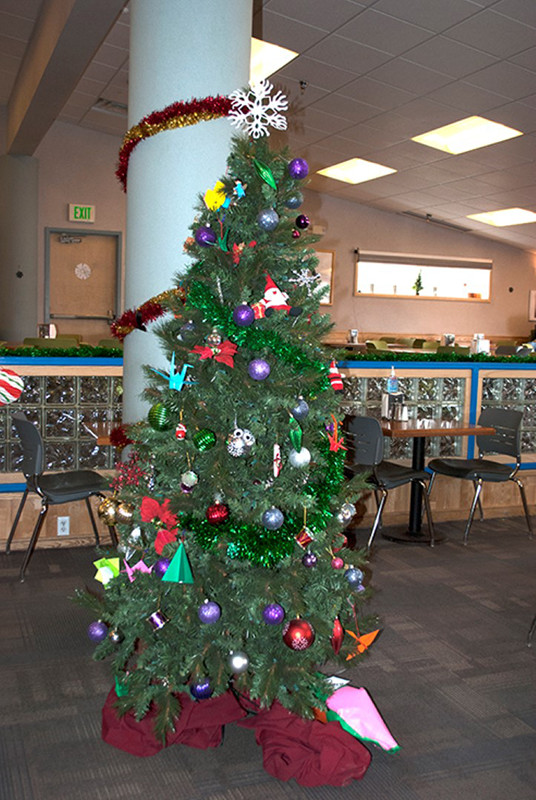
Photo Credit: Elaine Hood
Holiday decorations sprung up around the station, spreading seasonal cheer across the station.
December! It’s a month of sunshine. Because the temperatures have been climbing into the high 30’s, burbling brooks of melted snow have been winding their way through town and snaking their way into the bay. For the holidays, several work centers sprouted strings of Christmas lights, while decorations hewn-from-wood adorned the telephone poles around town. The galley was festooned with mistletoe and a menorah and Santa was even been sighted at Williams Field. It’s that month that’s riddled with holidays, outdoor activities, exciting science events and preparation for the busy resupply vessel weeks. In short, midsummer in McMurdo is here. The first Long Duration Balloon (LDB) launched on Nov. 29 near Williams Field. That experiment was the Boron And Carbon Cosmic Rays in the Upper Stratosphere (BACCUS) payload. During its journey high over the continent, it was measuring the nuclei of cosmic rays as they reach Earth’s atmosphere. Only four days later, on December 3rd, the Antarctic Impulsive Transient Antenna (ANITA III) floated off into the distance to train its array of radio antennae on the ice surface in order to observe ultra-high-energy neutrinos. Six days later, the Stratospheric Terahertz Observatory (STO) began its flight, studying the Interstellar Medium, which is the matter between star systems. A number of station residents who like to watch the balloons lift off were able to observe the launches from vantage points on Observation Hill or the crest of the road on the way to Scott Base.. On Dec. 26 not far from the LDB site, the first of three South Pole Overland Traverse (SPOT) convoys pulled into its staging area after a successful trip back and forth to Pole hauling fuel to keep the station running. While they weren’t at McMurdo for Christmas, it was nice to see long-missing faces at the tables in the galley and hear their voices on our radios as they go about their work. Not long after the New Year they’ll be on their way again, but it’s nice to have our friends on-station to ring in 2017. Several miles down the ice road, the Pegasus White Ice Runway, after 26 years of wheeled intercontinental flights, has ceased operations. December was spent moving all of the airstrip infrastructure – the firehouse, power plant, outhouses, fuel tanks, runway lights, electrical poles, and other support buildings – a few miles to their new home at the new Phoenix Airfield. For those of us who have worked at Pegasus, it was kind of eerie and a little sad to see “Pegasus Town” so empty. We are, however, excited to give Phoenix (named after a Lockheed Constellation plane that used to fly here like Pegasus did) a go. This month also saw the opening of the Erebus Bay Overlook hiking trail. An offshoot from the Castle Rock trail, it climbs up a small volcanic hill to offer views of Mount Erebus, the Erebus Glacier tongue and the collection of small islands off the coast of Cape Evans. While the Castle Rock hiking trail is gorgeous, sometimes you don’t want to make the seven-mile round trip. This trail gives you similar views in only a little over three miles round trip. Finally, the end-of-year holidays came upon us fast (as things are wont to do down here), replete with a slew of gatherings, parties, special meals and concerts. On the 23rd an LC-130 flew down from Christchurch just in time to deliver holiday gifts of fresh fruit, veggies and a pile of mail. Santa’s sleigh indeed! The Vehicle Maintenance Facility personnel scoured the floors and transformed the cavernous building into the “North Pole”… in Antarctica, complete with an appearance from Santa. In a smaller back room, musicians played acoustic sets while people sat back and absorbed the tunes. And of course, Icestock this year rang in the New Year with rock, electronica, funk, bluegrass and chili. Lots and lots of chili. As we start the new year, with well over half of the austral summer over, many of us start contemplating what comes next. Travel plans are being conjured, cover letters formulated for off-ice jobs and next season opportunities pondered. Those that are spending the winter here are ordering online or scrounging around station for the things that will help them through the long, cold, dark season. Soon the Polar Star will show up to start breaking up the sea ice in preparation for the Nathanial B. Palmer research vessel, the Ocean Giant resupply vessel and the Maersk Peary tanker vessel. Once the stream of ships arrives, it seems like time accelerates and suddenly we’re landing in Christchurch and tasting the humidity in the air. But for now, we have a little while longer to enjoy the Antarctic climate, the ever-changing seascapes, an increase in wildlife, and on the 20th of February, the arrival of sunsets again. |
Home /
Around the Continent /
McMurdo Station Archives - 2017
"News about the USAP, the Ice, and the People"



For USAP Participants |
For The Public |
For Researchers and EducatorsContact UsU.S. National Science FoundationOffice of Polar Programs Geosciences Directorate 2415 Eisenhower Avenue, Suite W7100 Alexandria, VA 22314 Sign up for the NSF Office of Polar Programs newsletter and events. Feedback Form |

